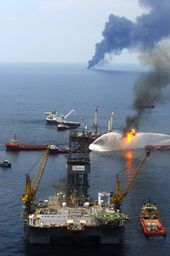
That timetable would conservatively unleash another half-million barrels of oil into the sea -- twice the Exxon Valdez spill. Using upper-end federal estimates of the leak, 840,000 barrels would gush out. That's 35 million gallons.
Coast Guard Adm. Thad Allen described the cut-and-run plan in a conference call to reporters at noon Friday -- about six hours before the National Weather Service announced that a tropical depression had formed in the Caribbean.
''Realistically, over an abundance of caution,'' the admiral predicted that Deepwater Horizon's well would remain uncapped for ''14 days'' if the storm headed into the area of the Gulf where the ships are collecting oil.
Allen also announced that Vice President Joe Biden would visit the Florida Panhandle on Tuesday.
Hurricane contingencies have become major concerns for planners trying to clean up the runaway Deepwater Horizon spill in its 67th day.
The National HurricaneCenter on Friday evening declared a rainstorm off the coast of Honduras to be Tropical Depression One, the first of the Atlantic season.
Tracking maps showed the mass becoming a named tropical storm by Saturday, but the path shows it more than five days away from the Deepwater Horizon disaster site.
In Washington, Allen told reporters that planning for a hurricane would require an evacuation of the wrecked oil rig's site once 40-knot winds are predicted to arrive within five days.
That means unplugging the makeshift system called a ''top hat'' that has been collecting a portion of the gushing crude.
Were there a coming hurricane, coastal cleanup efforts would also be abandoned in the Gulf, said Allen, who until recently was the commandant of the Coast Guard.
''I don't think anyone wants a vessel out there trying to skim oil with the weather building beyond gale-force winds,'' he said.
''In general,'' he said, describing robust contingency planning, ''at about 120 hours out of the onset of gale-force winds, we will start to redeploy the equipment from the well site, redeploy other equipment to safe venues, and then come in after the storm to reestablish production or to take part in rescue activities with the Coast Guard.''
In other developments Friday, the Panhandle's westernmost county, Escambia, rescinded a portion of a health advisory that had been issued Wednesday after the largest arrival of sludge on Florida shores of the spill.
Swimming was safe again, the notice said, from Public Walkover 23 at Pensacola Beach to the entrance of Fort Pickens National Park.
Health officials were working with the National Parks Service to determine if the health advisory for the beaches of Fort Pickens and Johnson Beach could also be lifted.
''This is a highly dynamic situation varying by tide, current, and wind changes/direction,'' said health department director Dr. John Lanza. ''We expect to frequently give and rescind advisories along our beaches.''



Reader Comments
to our Newsletter